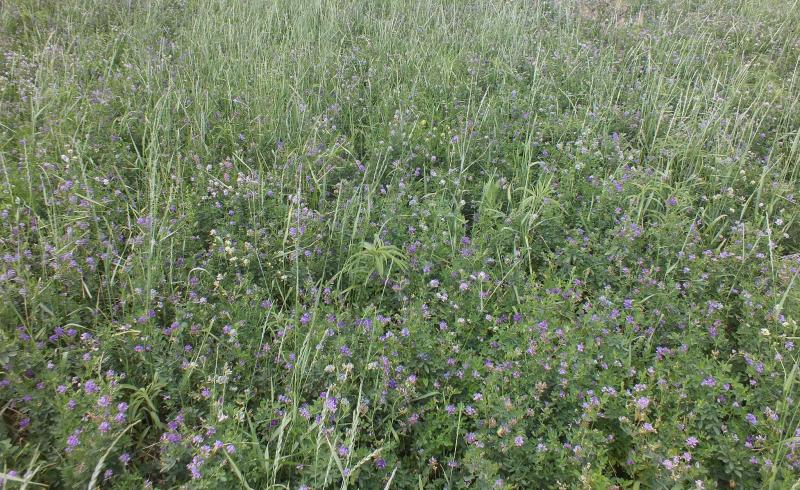
Written with collaboratively by Adele Harty, former SDSU Extension Cow/Calf Field Specialist; and Ken Olson, former Professor & SDSU Extension Beef Specialist.
Alfalfa weevil populations are high this year, creating challenges for producers. In some instances, the economic threshold has been surpassed and the value of the forage has decreased, especially when the window for utilizing insecticide has passed. Questions have arisen on how to get some value out of the forage by grazing it rather than putting it up for hay. This is an option, but there are precautions that need to be taken. For information on alfalfa weevil scouting, economic thresholds and management options see It’s Time to Scout for Alfalfa Weevils.
Based on the level of weevils present, the feed value of the alfalfa may be adequate to meet nutrient requirements of beef cattle, unless the plants have been stripped with very little leaf material remaining. When considering grazing options for alfalfa, the greatest concern is bloat risk. There are various management practices to decrease bloat risk while utilizing the forage.
To mitigate bloat risk, it is important to have a complete understanding of bloat. So, what causes bloat? Alfalfa is highly digestible and contains highly soluble protein. The more immature it is the higher the soluble protein content. This means higher risk of bloat due to the percentage of protein being high in relation to fiber. When protein content is high and fiber content is low, the rumen microbes access the protein very easily and quickly through the digestion process. As a result, microbes release gas which builds up rapidly in the rumen. At the same time, the soluble protein bonds with carbohydrates and other nutrients to form a slime layer. The slime forms a coating on gas bubbles, creating a frothy foam that the gas cannot escape from. With frothy bloat or pasture bloat, cattle cannot belch to eliminate the gas. Because the gas cannot escape the rumen, the classic bloated appearance develops. The gas pushes against the diaphragm which can suffocate the animal by keeping the diaphragm from being able to move air in and out of the lungs.
Management Considerations
There are various management practices to decrease bloat risk with cattle grazing alfalfa. Depending on specific situations, these practices can be implemented to decrease risk.
- Wait until mid- to full-bloom to graze. As the plant matures, the soluble protein decreases, plant cell walls thicken, lignin increases and rate of digestion decreases, resulting in decreased bloat risk. At 15-20% bloom the risk of bloat drops substantially and continues to decrease with further maturity.
- Ensure cattle are full when turning in to graze alfalfa. It may be valuable to provide access to dry hay before or during grazing of legume-based pastures.
- Implement intensive rotational grazing for uniform and regular intake of the entire alfalfa plant rather than just the most digestible parts. However, don’t overgraze to the point of hunger before moving cattle for both the health of the cattle and alfalfa. Intensive rotational grazing also minimizes grazing of regrowth, which provides more bloat risk than mature forages.
- Make paddock rotations mid-day. Soluble protein is higher earlier in the day. Additionally, wait until morning dew is off. If the plants are moist with dew, rain or irrigation water, the rate of intake and initial rate of digestion are higher. Never turn in early in the morning: mid- to late-afternoon is better.
- Factors that increase bloat risk include storms, exceptionally hot weather, and biting flies because they alter feeding patterns.
- Understanding patterns of grazing behavior are important to monitoring bloat risk. Cattle will graze multiple times throughout the day, but usually have major grazing bouts in the morning and evening. Bloat normally occurs 1 to 1 ½ hours after a major grazing bout, so monitor during these times to catch bloat early. Be prepared to move chronic bloaters to a different area.
- Have a non-legume pasture to go to in case bloat becomes a serious problem, but don’t move them in and out frequently as the rumen microbes do not have time to adapt to the alfalfa and bloat can continue to be a problem.
- Provide anti-bloating agents such as poloxalene (Bloat Guard®). This depresses froth and foam formation. Begin feeding two to five days before turning onto alfalfa pasture. It will help prevent bloat for about 12 hours, if it is consumed in adequate quantities. However, poloxalene is relatively expensive.
- Ionophores, especially Rumensin®, are known to reduce gas production in the rumen and therefore can reduce the potential for bloat. A supplemental feed will need to be provided to serve as the carrier to deliver the ionophore. Be careful that the supplement is a limited source of additional soluble protein (i.e. use grain or low-protein byproduct feeds such as soy hulls or sugar beet pulp).
- Have a bloat treatment kit ready and available. This kit should include a stomach tube or 1 inch diameter hose, defoaming agent, and a bloat needle or trocar and cannula.
For more information, contact Adele Harty, SDSU Extension Cow/Calf Field Specialist; Ken Olson, Professor & SDSU Extension Beef Specialist or another SDSU Extension expert.


